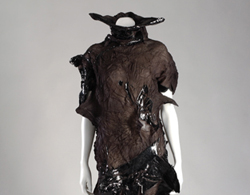Did that dress just move?
You bet. And it wasn’t because the model put one high-heeled hoof in front of the other.
In his spring 2007 collection, two-time British Designer of the Year Hussein Chalayan stunned Paris runway crowds with a set of couture dresses that seemingly had a mind of their own. Zippers zipped, hemlines rose, sleeves shortened – but by no means of their own accord. It was a feat of fashion fused with technology, a concept currently on display in “Fashion and Technology,” an exhibit at The Museum at FIT (Fashion Institute of Technology) in Manhattan that documents the evolution of innovation in fashion leading up to achievements like Chalayan’s.
“Chalayan had collaborated with some of the people who were doing mechanics for Harry Potter to create these mechanized garments, which were controlled behind the scenes,” says the show’s co-curator Ariele Elia.
Other than employing the magic of Hollywood, the bulk of the designs on display from the museum’s permanent collection illustrate the magic of modernization starting with the Industrial Revolution. Historic inventions in their day like sewing machines, synthetic dyes (purple) and plastics simulating tortoiseshell and ivory represented the peak of progress. Tough to imagine, but even rubber was revolutionary at one point, adorning early iterations of ecru-colored Keds. But some of the real fun – it may not surprise – began in the 1960s.
“The next place people would be vacationing was space,” says Elia, directing eyes to a plastic eggshell dress with matching boots and goggles. “So André Courrèges wanted to create a very fashionable piece if you are going into space.”
Cut to the ’80s, where we all have Marc Audibet to thank for his development of that Lycra-based wardrobe lifesaver, stretch fabric.
“One thing we take for granted is the bi-stretch material that Marc Audibet was working with,” says Emma McClendon, the show’s other co-curator. “He was the first to apply Lycra to this high-fashion level.”
The manipulation of polyester indicated another progressive move in high fashion. Note a sheer, black polyester and polyurethane masterpiece by lauded textile innovator Yoshiki Hishinuma. His fall 1999 tube dress used a heat application process to create an avant-garde texture and volume with “rubberized” features and sporadic peaks.
The last 15 years represented in the show emphasize the increasing incorporation of tech elements into couture lines, yet also an increasingly blurred line of where fashion ends and technology begins – whether in tech-inspired garments, interactive apparel or space-age attire.
Take Jean Paul Gaultier’s 1996 cyber graphic spandex jumpsuit inspired by the sci-fi flick “Mad Max.” The “second skin” sports a computer-generated polka dot print that contours to the female form. Simon Thorogood drew inspiration for a hooded dress from futuristic pilotless drones and Balenciaga’s enamel-coated frock taps into what the designer calls a “futuristic vision of femininity.”
Technology is incorporated into designs now more than ever.
“While they’re two very different fields, they’re also very similar,” Elia says. “When you look at fashion in technology there can be kind of that missing link sometimes. You can create a completely wired garment, but there is no fashion in it – or vice versa.”
For a practical blend of both, turn on the museum’s Luminex blouse, made with fiber optic technology that lights up like layers of linear constellations, and imagine the ease of a jacket prepped to play music or answer a call from its sleeve – equipment Elia calls “pretty mainstream now.”
Branding fits especially well into fashion’s tech mix. Take a gander at Burberry’s holographic catwalk at the opening of the Beijing flagship store or the ultra fashionable, ultra transformable Max Mara Cube Coat complete with its own iPad app, with which users can select interchangeable accessories to fulfill multiple style needs.
“In thinking about a futuristic wardrobe, people always think about seamless things – one garment,” Elia says. “This kind of goes along with that idea.”
And keep your eyes peeled for one of the newest digital devices hitting the fashion market – the LilyPad, a microcontroller board designed for wearables and e-textiles. Its creator, MIT professor Leah Buechley, already proved its fashion functionality.
“She’s a cyclist who’s put LED lights into her garment,” Elia says. “If she works her left hand, her left blinker will blink. And if she works her right hand, her right blinker will blink. She has a stop sign as well.”
Talk about clothes that stop traffic.
“Fashion and Technology” runs through May 8. For more, visit fitnyc.edu.

